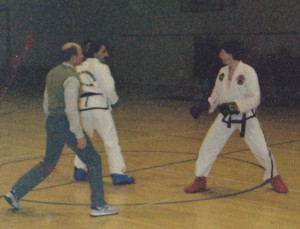HOW TO TEACH SPARRING SAFELY
One of the key reasons that students both adults and children, give up training is commonly because they start sparring too soon. Their introduction to sparring is very abrupt, resulting in demoralization and then finally drop out. For others, it could just simply be the result of the lack of control with level of contact in the class.
Sparring should be taught by the Principle of Progression so you should structure the curriculum to gradually introduce the student to sparring.
The 3 Phases of Sparring Progression
Phase 1
- Teach basic techniques remaining on the spot.
- Focus on improving fitness
- Work on footwork drills
- Target practice on shields
Phase 2
- Drills against equipment wearing the sparring gear to get used to it
- Lots of sparring drills which are non competitive but focus on fitness and accuracy
- Light contact sparring leading to competitive situations.
Phase 3
- Medium contact
- Lots of conditioning and fitness

Sparring without headguards is a thing of the past as demonstrated by Cyril McSweeney and Frank Murphy at the Neptune stadium 1984. Always be safe in your training and wear a headguard.
Teaching Sparring by the Principle of Progression
1. Basic kicking & hand techniques
(in a stationary position,
use cue words, ‘chamber, extend, recoil)
2.Expand on these techniques
e.g. step in side kick
3.Kicking and punching combinations
(Teach by transfer)
4.Perform skills against a stationary shield
Or large bag – light to medium force
5.Repeat with a moving shield so that
Distance and timing is learnt
6.Replace the shields with smaller hand pads
therefore requiring more accuracy.
Repeat 4 & 5 with small pads.
7. Sparring equipment must ALWAYS be worn.
Instructor specifies techniques (predetermined) against
Partner using light contact attacking and defending.
8. Light contact sparring attacking and defending
9. Light to medium contact sparring
 OTHER SAFETY CONSIDERATIONS WHEN TEACHING SPARRING
OTHER SAFETY CONSIDERATIONS WHEN TEACHING SPARRING
- Always ensure that your students are wearing the proper safety equipment and remind them to look at the sparring rules in the licence book.
- VERY IMPORTANT: If you are ever sparring, always set an example by wearing full protective equipment.
- With children in particular, partner students of similar weights, never put a large child versus a small child.
- Avoid sparring yourself whilst teaching as you will be taking your eyes off the class, unless you have another instructor assisting you.
- If there is a member who is the odd one out, do not be tempted to fall in to make up the numbers. Put them into a group of 3 and then rotate the group.
- Explain to students (adult beginners) that contact is inevitable during sparring activities. It is up to them to decide what is excessive and to inform there opponent politely to ease off. If it continues, they must inform the instructor.
- NEVER SPAR A CHILD OR ASK ANY OTHER ADULT TO SPAR A CHILD. Put the child up against and airshield or wavemaster and rotate the sparring partners.
- If a child shows excessive contact, get them to sit out and calm down for a while. Explain clearly why you are omitting them from the activity. Avoid using exercises such as press-ups as a punishment.
This Blog was an extract from Master Frank Murphy’s Instructor Training Course.




